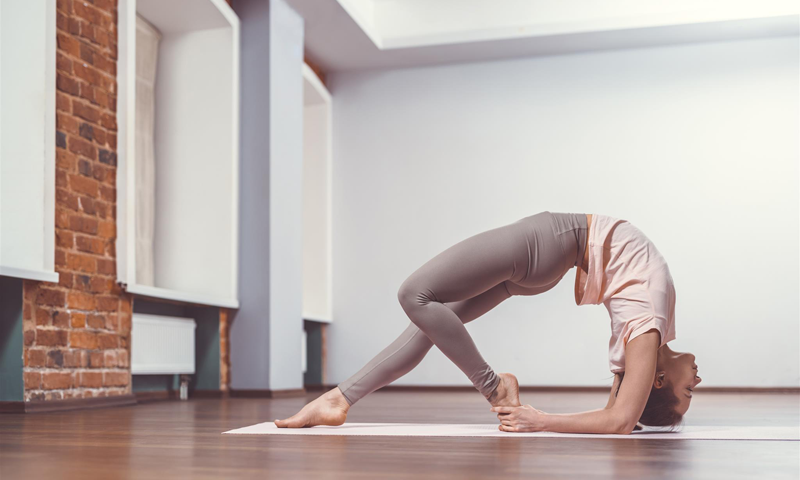
Can Yoga Help with Depression?
May 11, 2018
Is Yoga a Type of Therapy?
May 24, 2018What is Restorative Yoga?

In the busyness of modern life, it’s important to find time to relax and recharge. If we don’t give our body and mind some well-deserved down time, we can become overwhelmed, stressed, and exhausted. While most people understand the importance of relaxation, it’s not uncommon to find switching off a little tricky. Thankfully, that’s where restorative yoga comes in. With the ability to calm a racing mind, restorative yoga can help anyone to recharge their batteries. Additionally, the practice can relieve a variety of health conditions, making it ideal for those suffering from chronic illnesses or recovering from a physical injury. All you need to practice restorative yoga is some comfortable yoga clothes. As we are approaching the summer months, a lightweight vest top would be ideal. In this article, we explore restorative yoga in more detail.
What is Restorative Yoga?
Restorative yoga uses gentle asanas to slow down and open the body. Unlike most contemporary yoga classes, restorative yoga requires minimal movement. This makes the practice adaptable to people of all abilities – even those with physical limitations. While each class is different, most restorative sessions involve moving gently from pose to pose, building strength and flexibility as you do so. Though the practice can improve your fitness levels, it focusses primarily on relaxing the body and mind.
Restorative yoga uses many of the same asanas as other yoga forms; however, practitioners are encour-aged to hold each posture for a longer duration during a restorative class. This allows the muscles to relax on a deeper level. To further encourage relaxation, the body is often supported with props to eliminate unnecessary straining. Typically, a range of blocks and bolsters are used to support the body, though blankets or pillows can be used as an alternative. Some yogis prefer to use a soft blanket over a yoga block.
How to Practice
While all restorative classes are unique, the basic structure of each session is always similar. Typically, ses-sions will take place in a standard yoga studio. To create a relaxing environment, many teachers choose to play soft music and dim the lights. While restorative yoga isn’t a hot yoga style, the studio will always be kept at a comfortable temperature. If you’re worried about getting chilly, consider taking a sweatshirt and some thick socks along with you. If you’re lucky, your local studio may provide cozy blankets to wrap up in, if you so wish.
When you have settled into the session, you will perform a range of restorative yoga poses. Typically, the asanas will be supported with props and be held for an extended period of time – often up to fifteen minutes. Whilst performing each pose, you are encouraged to focus on your breathing. Sometimes, the instructor may talk you through a meditative technique to enhance relaxation. As each posture is per-formed for longer than usual, it’s not uncommon to only use four or five poses per class.

Restorative Yoga Poses
Supported Child’s Pose
Working to relieve muscular tension, Supported Child’s Pose is often used in a restorative yoga class. Before practicing the posture, make sure that you have a blanket or large pillow to hand. To begin the asana, kneel down on your mat with your pillow laid out in front of you. Next, sit back on your heels and straighten the spine as you inhale. As you exhale, slowly walk your hands out in front of you until your chest is resting on the pillow. Finally, place your forehead on the pillow and rest your arms down by your sides. You are in Supported Child’s Pose. Hold the pose for around 10 minutes, or as long as the posture feels comfortable.
Legs Up The Wall Pose
Another restorative asana, Legs Up The Wall Pose, works to release tension in the neck. In addition to promoting relaxation, the posture is great for relieving a headache. To practice the asana, place the shortest side of your yoga mat against a wall. When your mat is in place, sit down facing the wall. Gently lie back on the mat and extend both legs up the wall. Make sure that your bottom is almost touching the wall and that your legs are close together. You can either rest your hands on your stomach or on the mat – whatever feels most comfortable. You are in Legs Up The Wall Pose. Hold the pose for up to ten minutes with your eyes closed.
Corpse Pose
Encouraging the body to completely relax, Corpse Pose is a great way to end a restorative yoga session. Better still, the posture is easy to practice! To perform the pose, simply lie down on your back with your legs stretched out. Finally, rest your arms down by your sides. You are in Corpse Pose. Take this time to concentrate on your breathing for as long as you feel happy doing so. As well as promoting relaxation, this posture can be used to stimulate the digestive system. Whilst on the mat, try bringing your knees to your chest. After a few seconds, straighten them back down to the ground. This additional step will help to eliminate gas and combat constipation.
In Summary
Whether you’re an experienced yogi or a complete beginner, restorative yoga can be used by people of all sorts. With the ability to calm even the most frantic minds, the practice is the perfect way to relax after a busy week. While the studio is heated to a comfortable temperature, it may be worth picking up a yoga hoodie if you’re prone to feeling the cold. If you’re a little strapped for time, restorative yoga can be prac-ticed from the comfort of your own home. This way, you can fit your practice around your daily schedule.

